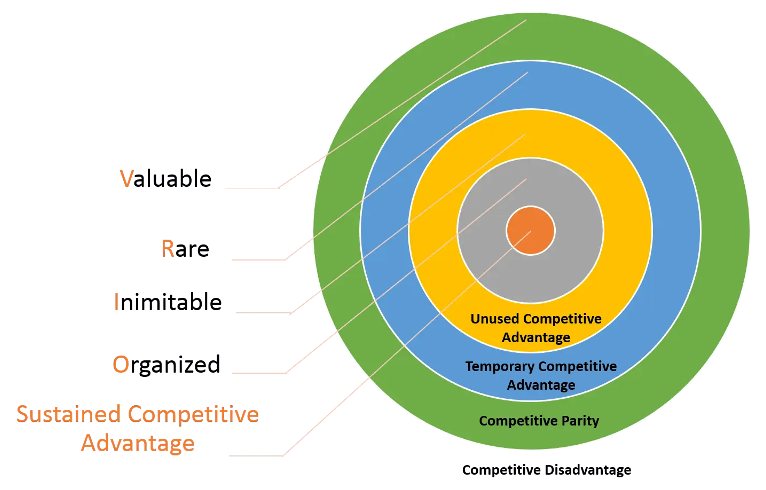What sets your company apart? When do you expect your rivals to catch up to you? Far too many businesses, when faced with this sort of inquiry, have no answers and instead rest their hopes on sheer tenacity.
The VRIO framework is a tool for strategic planning that aims to help businesses find and safeguard their competitive advantages. Please keep in mind that we are not referring to a simple inventory of your strengths, which could include things that other organizations excel at as well. We are also not talking about temporary benefits. Advantages in the market that can be replicated by rivals with little effort and for an extended period of time are not considered sustainable.
A VRIO analysis can help you find and capitalize on your sustainable competitive advantages, whether you have one or many. This article will explain what a VRIO analysis is, provide an example of a VRIO framework, and discuss how to apply the results of your VRIO analysis.
How does the VRIO model help find a “sustainable competitive advantage”?
The resources and capacities of an organization can be assessed using a four-question framework known as VRIO. These questions center on value, rarity, imitability, and organization. A decision tree can be used to plot the results of your investigation according to whether or not a given resource was found to satisfy the criteria.

Create a list of your assets and skillsets before you dive in. Patents, machinery, people skills, cost advantages, or anything else can fall into this category, but it can also include intangible items like material, financial, or human resources. Although it is not always the case, intangible assets are where long-term competitive advantages can often be found. Each item on this list must be judged using the VRIO framework’s four criteria:
Value: Do you supply a useful tool that patrons will find useful? Can you use an in-house strength to seize a chance or thwart rivals?
No: You are falling behind the competition and need to reevaluate your strengths and weaknesses in order to find new opportunities.
Yes: Once worth has been established, the VRIO analysis can move on to rarity.
Rarity: Do you have access to limited means or capabilities? Do you have a rare and valuable item that people are always looking for?
No: Your business is on equal footing with the competition because you offer value but aren’t particularly rare. Your valuable but widely available resources reduce your advantage in the market (but not impossible). Going back a stage and reevaluating is advised.
Yes: Your next obstacle is imitability once value and rarity have been determined.
Imitability: Is it costly for your company to produce an identical resource or capability? Is a suitable alternative readily available to your products and services?
No: If your resource is valuable and scarce but cheap or easy to replicate, you may enjoy a brief competitive advantage. Keeping up with the competition and setting yourself apart from the pack will take a lot of work; take a step back and reevaluate.
Yes: The attention is now on your organization because you provide something valuable, uncommon, and difficult to duplicate.
Organization: Does your business have well-organized management systems, processes, structures, and culture that allow it to make the most of its assets and potential?
No: It will be challenging to fully realize the potential of your valuable, rare, and expensive-to-imitate resources without the internal structure and assistance. Your business will possess an untapped competitive advantage, so you’ll need to reconsider how to build the required structure.
Yes: When your business has correctly identified all four elements of the VRIO framework, it has successfully attained its ultimate goal of sustained competitive advantage.
A Real-life VRIO Example: Google
Google is undeniably one of the most influential companies in the world, and its success may be traced back to a distinct advantage in human capital management. From a human resources point of view, we could describe Google’s VRIO framework as follows:
Value: Hire and keep creative, hardworking people by analyzing data from your human capital management system. Every year, these workers produce some of the most sought-after goods in the world.
Rarity: No other company makes such extensive use of data-based employee management.
Imitability: Human capital management that relies heavily on data is expensive and, at least for the time being, difficult to replicate. The onus is on businesses to develop the necessary software and to provide human resources with training in the new technologies and techniques.
Organization: Google has set up its business model to profit from this capability. IT has the know-how to gather and maintain the data, and HR and team leaders have had training in how to use the information to make better hiring, promotion, management, and performance decisions.
Google was able to rethink its approach to human capital management thanks to the availability of a VRIO framework that provided access to vast amounts of objective data. The People Operations group at Google, for instance, wanted to learn more about what qualities make for effective managers. Surveys, evaluations of performance, and suggestions of outstanding managers were among the sources used to reach this conclusion. Google also interviewed its best and worst managers in a blind fashion. Google’s internal team and the basis of its sustained competitive advantage are strengthened by the company’s efforts to define what makes a great manager. (Source: Strategic Management Insight, “VRIO Framework.”)
What are some benefits and limitations of the VRIO framework?
The majority of businesses don’t spend enough time investigating their core competencies. We think it’s a good idea to do this because:
- You can now take advantage of advantages in the market that you didn’t have access to before.
- It can serve as a compass for future endeavors and a guide for allocating company resources effectively.
- It can yield findings that may be used to rank the relative importance of various opportunities and threats.
The VRIO framework can help you assess your standing in the market and gain strategic insights, but it does have some restrictions:
- Keeping an edge over the competition over a longer period of time than three to five years is challenging in today’s volatile business climate.
- Because they lack the established resources and capabilities to establish a lasting competitive advantage, startups and smaller businesses may have more trouble applying the VRIO framework.
- You will need additional frameworks (such as the SWOT analysis) to fill in the gaps that VRIO, an inward-looking analysis, leaves behind.
When compared to a SWOT analysis, how does the VRIO framework differ?
You’ve probably heard of a SWOT analysis if you’re familiar with strategic planning. While both SWOT and VRIO can be useful in the early stages of strategic planning, the insights gained from using each tool are distinct.
The VRIO framework is designed to aid in the identification of the specific internal resources that give your business an edge over the competition.
However, SWOT (which stands for “Strengths, Weaknesses, Opportunities, and Threats”) is a more abstract strategic planning model that can be used to assess an organization’s internal and external strengths and weaknesses. Its goal is to assist you in evaluating your future prospects based on your current position and external conditions rather than conducting an in-depth evaluation of your internal resources like VRIO.
The question is, what do you do with the VRIO findings?
A VRIO analysis should be performed before developing a strategy to ensure success. In particular, this activity will help you craft a vision statement for your company that accurately describes its long-term goals. What VRIO reveals about your competitive advantages and market niche will inform crucial strategic decisions that will shape your business’s future. Therefore, consider how you can optimally utilize VRIO assets to deliver maximum value to the customer, and use that knowledge to craft a clear mission statement.
You can also use the VRIO model to guide your SWOT analysis. A SWOT analysis’ “Strengths” section should include any competitive advantages found. You shouldn’t label a resource or capability as a sustainable competitive advantage unless it meets all the criteria; that’s where your uniqueness lies. However, even resources that don’t pass the full VRIO test can still be considered strengths (for example, if something is VRO—valuable and rare, and your organization can capitalize on it). A resource can be considered a “weakness” or an area in need of improvement if it is not currently providing a sustainable competitive advantage and you would like to change this.
Both the VRIO framework and the SWOT analysis play significant roles in the formulation of a strategy. After a thorough strategic plan has been developed, concrete steps must be taken to bring it to fruition. In order to turn their strategy ideas into a workable plan, many businesses use a strategic framework (such as the Balanced Scorecard) and strategy software (such as ClearPoint) to break down the big picture into smaller, more manageable goals.
Also read: https://samahitawirotama.com/vrio-framework/



